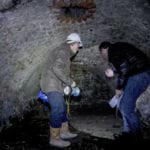 Technology
Technology  Technology
Technology  Humans
Humans 10 Everyday Human Behaviors That Are Actually Survival Instincts
 Animals
Animals 10 Animals That Humiliated and Harmed Historical Leaders
 History
History 10 Most Influential Protests in Modern History
 Creepy
Creepy 10 More Representations of Death from Myth, Legend, and Folktale
 Technology
Technology 10 Scientific Breakthroughs of 2025 That’ll Change Everything
 Our World
Our World 10 Ways Icelandic Culture Makes Other Countries Look Boring
 Misconceptions
Misconceptions 10 Common Misconceptions About the Victorian Era
 Mysteries
Mysteries 10 Strange Unexplained Mysteries of 2025
 Miscellaneous
Miscellaneous 10 of History’s Most Bell-Ringing Finishing Moves
 Technology
Technology Top 10 Everyday Tech Buzzwords That Hide a Darker Past
 Humans
Humans 10 Everyday Human Behaviors That Are Actually Survival Instincts
 Animals
Animals 10 Animals That Humiliated and Harmed Historical Leaders
Who's Behind Listverse?

Jamie Frater
Head Editor
Jamie founded Listverse due to an insatiable desire to share fascinating, obscure, and bizarre facts. He has been a guest speaker on numerous national radio and television stations and is a five time published author.
More About Us History
History 10 Most Influential Protests in Modern History
 Creepy
Creepy 10 More Representations of Death from Myth, Legend, and Folktale
 Technology
Technology 10 Scientific Breakthroughs of 2025 That’ll Change Everything
 Our World
Our World 10 Ways Icelandic Culture Makes Other Countries Look Boring
 Misconceptions
Misconceptions 10 Common Misconceptions About the Victorian Era
 Mysteries
Mysteries 10 Strange Unexplained Mysteries of 2025
 Miscellaneous
Miscellaneous 10 of History’s Most Bell-Ringing Finishing Moves
Top 10 Haunted Sites In Ireland
Ireland is a land steeped in a wide variety of mythology, folklore, and superstition. From Druids to Christians, famine to invasion, Irish history offers a lot to work with when it comes to otherworldly manifestations. Below are just ten of the thousands of sites across Ireland said to be scarred by people on the other side.
10Dunluce Castle

Dunluce Castle stands on a rocky outcrop just off the coast of County Antrim in Northern Ireland. Although it stands in considerable ruin today, Dunluce Castle is one of Ireland’s oldest and finest castles. Built in the 14th century, the castle was besieged and defended by rival Irish & British families for generations, which gives us our first apparition.
One of the most commonly reported sightings at Dunluce Castle is that of a man in 14th-century clothes. It is believed that this is the ghost of Richard Óg (Young Richard), who became one of the most powerful men in Ireland when he was just 12 years old.[1] He spent the rest of his career oppressing the local people, and it is believed that his spirit is doomed to remain earthbound because of some unspeakable evil he committed.
Our second specter is Maeve, said to be the soul of a young woman whose father forbade her from marrying the man she loved. When she tried to escape with her lover, her boat was overturned by a storm as her horrified father looked on helplessly. Visitors can now hear the sounds of sweeping and singing coming from her bedroom, as well as the ghostly apparition of a woman looking out over the cliffs.
Dunluce’s most famous story, however, is that of the accident in the kitchen. One of the castle’s most striking features is just how precariously it dangles over the edge of the cliffs. Over the years, parts of the castle have fallen away, most famously in 1639, when the castle kitchen collapsed into the sea below, taking eight people with it, and leaving just one small boy cowering in the corner. It is said the screams of the doomed residents can be heard reverberating to this day, particularly on stormy nights.
9Marsh’s Library

While many ghosts are said to haunt the world because they were killed or betrayed in some way, some spirits are not mad—they are just disappointed. Such is the case of the ghost of Archbishop Narcissus Marsh, who haunts Marsh’s Library in Dublin.
Marsh first established his library in 1701, when he realized that Ireland had no free libraries available to the public. His endeavor was a success, and the library remained the only free, public library in Dublin for over a century, and it continues operating to this day.
Despite his cultural contribution to the country, Marsh himself seems to be unable to rest in peace, and he reportedly hangs around the library to this day. The reason for this, historians believe, can be found in a diary entry from Marsh dated September 10, 1965.[2] In it, Marsh details how Grace, the niece he raised as his own, had fled in the dead of night, married an unscrupulous sailor, and consummated the marriage. As an Archbishop, Marsh was heartbroken by the news of Grace’s godless activities, and he never recovered from the grief. According to legend, it was only after Marsh died that he learned of a note hidden away by Grace in one of the books. His ghost now haunts the library, searching for the note, and for closure.
8Renvyle House
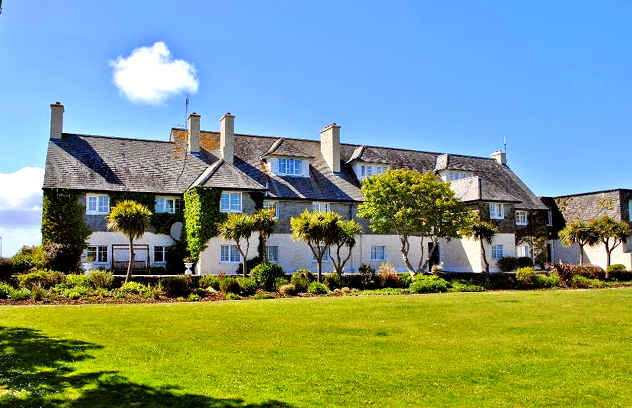
Renvyle House is a beautiful country house on the west coast of Ireland. After being burned down by the IRA, it was rebuilt and opened as a hotel in the 1930s, with its first guest being none other than famed Irish poet W.B. Yeats. Yeats was famously a lover of all things paranormal, and he lived in nearby Thoor Ballylee, a castle he also believed to be haunted. He would frequently visit Renvyle House to perform séances with his wife, who he believed was his own personal medium.
During one such seance, Yeats’s wife, Georgina, supposedly caught a glimpse of a pale, red-haired boy no older than 12 reflected in the mirror. The spirit was said to bear the appearance of “tragedy beyond the endurance of a child.” It is believed that this is the ghost of Harold Blake, a member of the original inhabitants of Renvyle House who hanged himself when he was still a child. Harold apparently told Yeats that he hates people coming into what he sees as his house, and he tries to drive visitors away by haunting them. Yeats performed an exorcism and told the child to walk the house no more.
Whether he was successful in ridding Renvyle of its paranormal scars is unclear, but a photo taken in Yeats’s nearby home just a few years ago has some locals convinced that the boy no longer walks those grounds: he walks the grounds of Thoor Ballylee.[3] It is said that Yeats and Blake developed a friendship as they communicated across different dimensions. But if the boy is hoping to find Yeats at home, he is doomed to irony, as Yeats is now said to be Renvyle’s resident ghost, with sightings of a tall figure in Room 27 taking precedent over the previous spirit.
7Huntington Castle
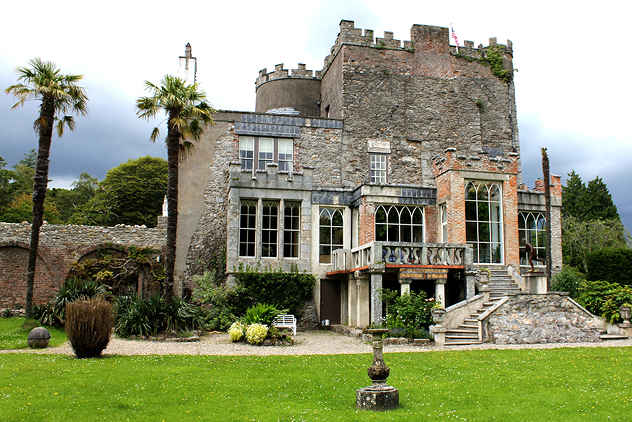
Situated on a major road leading from Dublin, Huntington Castle has played a major role in Irish history throughout the past 900 years. Originally built as an Abbey, the site soon expanded to become a fortified castle. The castle changed hands several times over the next few centuries, with many of the owners extending it further until it became the sprawling relic it is today.
The castle is said to be haunted by a wide variety of spirits, such as the ghost of a monk, presumably from the site’s days as an abbey in the 12th century.[4] In the attic, it is claimed that you can hear the marching of Cromwellian soldiers, who seized the castle in 1650 during the invasion of Ireland. Another religious figure, the ghost of Bishop Leslie, is said to haunt those who sleep in his old four-poster bed. Finally, you have the spirit of Ailish O’Flaherty, a former resident and granddaughter of the Irish “Pirate Queen” Grace O’Malley. Ailish, it is told, can be seen with the ghost of a white cat, combing her hair.
But the castle’s strangest feature is one you will not find much of in Ireland. In 1976, the basement, including the old dungeons, was converted into a temple for the ancient Egyptian goddess Isis. Although the temple appears to be free of mummies and scarabs, it is hard to imagine that the owners built it and have never attempted any ancient Egyptian rituals.
6Hellfire Club
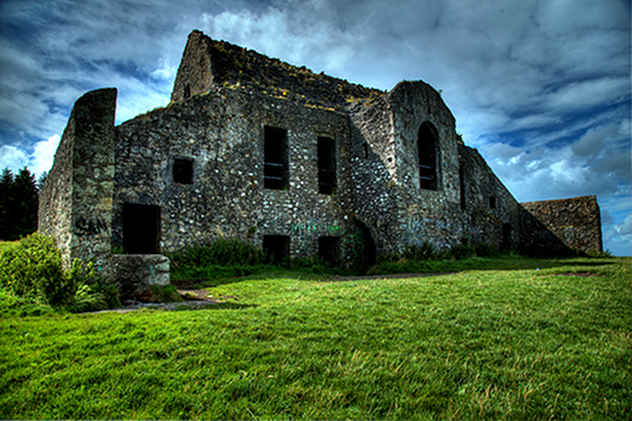
Hellfire Clubs were typically nothing more than you would expect from something with such a name today: places where wealthy locals would go to engage in gambling, drinking, and some even more adult acts. Although popular across Ireland and Britain in the 18th century, Dublin’s Hellfire Club was by far the most infamous of the bunch, and it is considered by many to be the darkest site in all of Ireland.
It all began with the construction of the club in 1725. As we all know, the two golden rules of construction are: always measure everything twice, and do not tear apart ancient tombs for building material. Unfortunately, the builders chose to ignore at least one of those rules and used a couple of thousand-year-old passages to get the job done. In retaliation, the devil is said to have blown off the wooden roof, which was replaced with one of stone.[5]
When the club was completed (by Ireland’s Grand Master Mason, no less), it was said to be a place of devil worship. Patrons could get away with anything, which included lighting a servant on fire, and rolling a woman down a hill in a flaming barrel. The club president would dress up as the devil, and sit by an empty chair reserved for the actual devil. One story tells of a man who dropped a card during a game, only to realize that his opponent had hooves for feet when he bent down to get it. Another tells of a local man so curious to know what was going on that he peered through a window. He was found the next day, lost and confused, and never spoke again.
The location is also known to be a hotspot for witches and Satanists to this day. One of the more common stories pertaining to witchcraft at the Hellfire Club is of the Black Cat. The cat is supposedly a demon that once battled a priest at the site. The dalmatian-sized animal has the face of a human, with big horns and glowing eyes, and can be seen prowling the ruins of Ireland’s most evil site.
5Dundermot Mound

Dundermot Mound is an unassuming little hill along a road in County Antrim, Northern Ireland. To drive past it, you would never know that this is one of the two main Gateways to Hell in Ireland (the other being a cave used by St. Patrick).
According to local legends, Dundermot Mound was used for ritual sacrifices in ancient times.[6] This may be the cause of the strange lights that are seen in the area at night. But as enticing as those lights may seem, witnesses to them should stay away, unless they want the ground to open up and drag them into the Otherworld. In 1798, that’s what happened to Thomas McHarg, now more commonly known as Black Tom.
McHarg was traveling by coach with his daughter from Belfast to Derry on a night that had been hit with a severe storm. Hoping to take the shorter, safer route, McHarg stopped along the way to ask, “Is the bridge at Glarryford still up?” as it had a reputation for breaking during storms. When he discovered the bridge was in fact down, he rerouted to Dundermot Mound, where his coach was promptly swallowed by the earth.
Today, witnesses of the lights risk falling victim to the same fate as Black Tom, although travelers should be wary of him also. It is said that Dundermot Mound sometimes spits him out, allowing his ghostly carriage to travel the road, asking if the bridge at Glarryford is still up. Those who speak back are cursed to die within a year.
4Rhetoric House
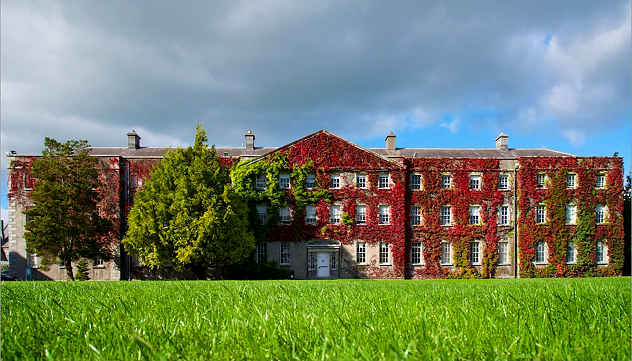
On the sprawling grounds of Maynooth University in County Kildare lies Rhetoric House, a place of unspeakable tragedy. In the house, which was once a dorm for the largest seminary in the world, is the infamous Room No. 2, or as it is known as these days, the Ghost Room.
The first part of the story takes place in 1841, which is when the first student committed suicide in Room No. 2. Having realized one of their friends was not in class, a number of students went to check on him. They found his body in a pool of blood, with his razor in his hand and a slash across his neck. The same thing happened to another student in 1860.
After the suicides, rumors began to swirl that the two boys had seen an image of the devil reflected in the mirror, which is what drove them to take their own lives. After the second incident, students even began storing their razors in ice-cold water, hoping the shock would prevent another suicide. It didn’t. Some time later, a third student took his life in Room No. 2. While the icy water seems to have prevented him from slitting his throat, he instead jumped out the top-floor window.
These days, nobody is allowed to bring a mirror into the room, which was eventually converted to a shrine to St. Joseph, who just so happens to be the patron saint of peaceful death. Bloodstains and hoof-burns can allegedly be seen on the floorboards to this day.
Less terrifying is the tale of the Aula Ghost,[7] a 1940s projectionist who has haunted the Aula Maxima theater since falling to his death. Legend has it that if he does not like your performance, he will turn his chair backward.
3Hungry Hall

Hungry Hall is a relatively isolated patch of land in County Kildare, just outside of Dublin. On it is the ruin of a small cottage that has been unoccupied for over 100 years. This is Hungry Hall, the former dwelling of a witch whose actions were so evil that her legend lives on strong to this day.
Based on court records, we know that these events took place in the early 19th century. Around this time, a lot of young boys in the area were disappearing, but there were no clues as to where they had gone or who took them, until the lucky day a passing traveler needed a light.[8] As the story goes, this was a man who used the road frequently, and so, would often pop into a little old lady’s house to light his pipe. On this occasion, the woman was not home, but since they were well-acquainted, he decided to let himself in and light his pipe off the fire anyway. As he bent over, he noticed a small foot protruding from the water boiling in the cauldron, and fled.
He returned with angry villagers, and the woman was apprehended and put on trial for witchcraft. She was found guilty, but since Ireland never really had a method of dealing with witches, there was some debate as to what should be done with her as they knew that a witch could not be buried on Catholic grounds. The solution, in the end, was to place a barrel of flaming tar underneath her as she was hanged near her home. Her body fell into the tar and was burnt away. Now, Hungry Hall remains abandoned, save for the giant black dog that patrols the grounds, which is said to be the witch herself in a new form.
2Clongowes
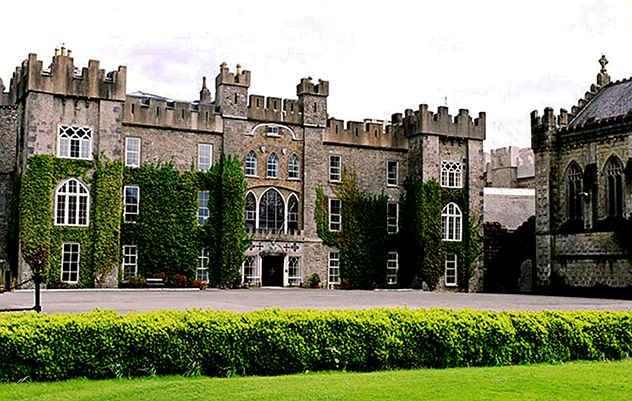
Clongowes is Ireland’s oldest Catholic school, with some buildings on the site dating as far back as the 13th century. During its lifetime, Clongowes has seen the invention of the printing press, the Renaissance, the discovery of the new world, and the rise and fall of too many kingdoms to count, right in its own front yard. It is no wonder then that in the past few centuries a couple of spirits have decided to hang around.
The most inexplicable of these apparitions is that of a ghostly dog with glowing eyes. Nobody knows whose dog it is, or why it haunts the grounds, but the ghost is not believed to be malevolent. There is also the spirit of a man, who has a slightly less murky backstory. This is allegedly the soul of a murderer who was hanged years ago and now wanders the grounds. Some people claim that the dog is the murderer taking on another form.[9]
But the most well-documented case at Clongowes is without a doubt that of a soldier dressed in white, blood pouring from his side. Seen by many people throughout the years, the first reported sighting of this specter dates back to 1757. At this time, the Wogan-Browne family lived in a castle on the site. One night, as the servants were downstairs, the door flew open to reveal a man dressed in white making his way down the hallway. He made no sounds, but he was clutching his ribs, which were bleeding profusely all over his immaculate uniform. Then, the manifestation burst into screaming flames and disappeared.
The servants described the man to the Wogan-Browne girls, who realized it must be their brother, Brian, who was fighting in the Battle of Prague. Two weeks later, word arrived that Brian had died on the night of the apparition.
1Flax House

Compared to many of the other sites on this list, Flax House has a relatively short and unbloody history. Built in Belfast in 1912, Flax House spent the next 54 years as a linen mill. During this time, there were two world wars, as well as the island’s less-than-peaceful split into two nations, so things like working conditions and hours were not top priority for the business. Women worked long hours in deplorable conditions until the mill closed in 1966.
Flax House is a beautiful, sprawling, five-story Edwardian building, so it was the perfect place for a printing house to be set up in the early 1990s. But employees immediately began complaining of otherworldly activities, including mysterious noises, and doors closing by themselves. One of the most commonly reported experiences was sudden drops in temperature throughout the building.
It was not long before the experiences became more tangible. Strange noises soon turned into the sounds of women shrieking and singing, while swinging doors evolved into all sorts of moving objects.[10] Various figures of women were seen, and employees constantly had a feeling that someone was moving about in the rooms with them, watching them. Soon, these workers became convinced of two things: the mill was haunted, and they were not crazy. So, in 1998, they filled the building with CCTV cameras and started streaming live.
The webcam became an internet sensation, with people from all over the world weighing in on what could be behind the hauntings. The main theory is that the mill is haunted by the ghost of Helena Blunden, a 16-year-old millworker with dreams of making it as a singer. Helena hated the mill, but she had just saved up enough money to quit and pursue her dream when tragedy struck. She slipped while she was cleaning and fell several stories to her death, damning her to spend eternity in the mill. She died on April 14th, 1912, the same night the Titanic struck the iceberg after sailing from Belfast.
Helena’s story may have some retribution though. In 1999, a small fire started in the mill. Fortunately, the old-fashioned fire extinguishers (buckets of sand) had been left up for decorative purposes. When the manager used them to put out the fire, he discovered a strange wax cylinder wrapped in cloth. It turned out to be a primitive recording of Helena singing that she had hidden away, and it can be heard here.
Simon still loves potatoes, and can still be followed on Twitter @simongireland
Read more about haunted places on 10 Most Haunted Cities In The World and 10 Haunted Asylums With Extremely Dark Pasts.

